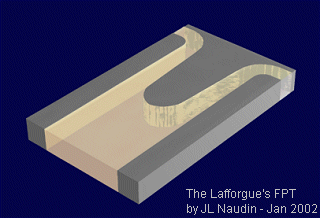The electrostatic forces
are "generated" by the interaction of
polarised atoms (q) on an electric vector field
(E), i.e. F=q.E, positive or negative according
to the sign of (q). By suitable geometry of the
polarised armatures, and/or by the use of
electric charges induced by induction effect,
and/or by the use of suitably arranged
dielectrics, it becomes possible to break the
symmetry of the expansion forces on one of the
axes of the three-axis reference system and thus
to obtain a non-zero resultant force (Fn). The
isolated system is then propelled, and it draws
the charges (q) and (E) along with it, thus F=q.E
remains constant. This force can be used as a
means of propulsion for any vehicle or even as
motive force for producing energy.
Systèmes
isolés auto-propulsés par des forces
électrostatiques
Les
forces électrostatiques sont " engendrées
" par interaction d'atomes polarisés (q)
sur un champ vectoriel électrique (E), soit F =
q. E positive ou négative selon le signe de (q).
Par une géométrie adaptée des armatures
polarisées, et / ou par l'utilisation de charges
électriques induites par effet d'influence, et /
ou par l'utilisation de diélectriques
convenablement disposés, il devient possible de
rompre la symétrie des forces d'expansion sur
l'un des axes du trièdre de référence et
obtenir ainsi une force résultante ( F n )
non nulle. Le système isolé est alors propulsé
et il entraîne avec lui les charges (q) et (E),
donc F = q. E reste constant. Cette force peut
être utilisée comme moyen de propulsion de tout
engin ou bien comme force motrice pour produire
de l'énergie.
Un très court
extrait de ce brevet ( 55 pages ) : "
Cette disposition permet à tout engin ainsi
équipé, et surtout aéronautique et spatial, de
pouvoir changer de direction extrêmement
rapidement, voire de s'immobiliser, puis de
repartir en sens inverse promptement…"
Full patent in PDF ( 2.3
Mb )
|


 FR Patent N°2651388 "Isolated systems self-propelled by
electrostatic forces"
by Lafforgue Jean-Claude - March 1, 1991
FR Patent N°2651388 "Isolated systems self-propelled by
electrostatic forces"
by Lafforgue Jean-Claude - March 1, 1991